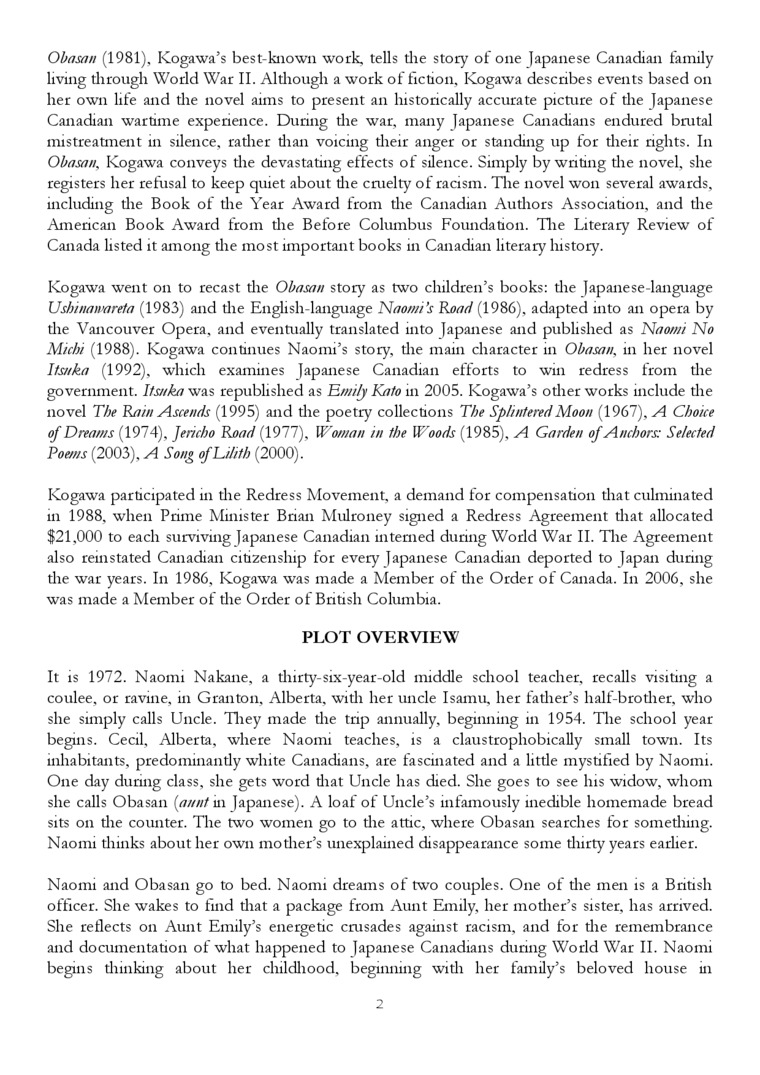108154

Ob asa n (1981), Kogawa’s best-known work, tells tlie story of one Japanese Canadian Family living dirough World War II. Although a work of fiction, Kogawa describes events based on her own life and tlie novel aims to present an lnstoncally accurate pictnre of tlie Japanese Canadian wardme expenence. During tlie war, many Japanese Canadians endured bmtal mistreatment in silence, ratlier dian voicing tlieir anger or standing up For tlieir riglits. In Obasan, Kogawa conveys tlie devastating eFfects oF silence. Simply by wnting die novel, she registers her relusal to keep quiet about die cnielty ol racism. Tlie novel won several awards. including die Book oF die Year Award From die Canadian Authors Association, and die American Book Award From tlie Before Columbus Foundation. Tlie Literary Review oF Canada listed lt among tlie most important books in Canadian literary lustory.
Kogawa went on to recast die Obasan story as two childreifs books: die japanese-language Uskinannreta (1983) and die Engjish-language Nao/ni’s Rok/(1986), adapted into an opera by die Vancouver Opera, and eventually translated into japanese and publislied as Nao/ni No Micbi (1988). Kogawa continues Naomi’s story, die mam character in Obasan, in her novel Ifsuka (1992), wlucli examines Japanese Canadian eFForts to win redress trom die government. Iłs/tka was republished as Hmiiy Kało in 2005. Kogawa’s odier works include die novel The Ka/n Ascends (1995) and die poetry collections The SphnteredMoon (1967), A Choice of Drea/ns (1974), Jericbo Road (1977), Wo/nan in łhe Woods (1985), A Garden of Anchors: Se/ecłed Poems (2003), y4 Song ofUliłh (2000).
Kogawa participated in die Redress Movement, a demand For compensation diat culminated in 1988. wlien Prime Minister Brian Mulroney signed a Redress Agreement diat allocated $21,000 to eacli survivnig Japanese Canadian intenied during World War II. Tlie Agreement also reinstated Canadian citizenslnp For every Japanese Canadian deported to Japan during die war years. In 1986, Kogawa was madę a Member oF tlie Order oF Canada. In 2006, she was madę a Member oF die Order oF Bntisli Columbia.
PLOT OVERVIE\\
It is 1972. Naomi Nakane, a dnrty-six-year-old middle scliool teacher, recalls visiting a coulee, or ravine, in Granton. Alberta, widi her uncle Isamu, her Fadiefs halF-brodier. who she simply calls Uncle. Tliey madę die tnp annually, begmning in 1954. Tlie scliool year begins. Cecil, Alberta, wliere Naonu teaches, is a claustrophobically smali town. Its inhabitants, predominantly wbite Canadians, are Fascinated and a little mystiFied by Naomi. One day during class, she gets word diat Uncle has died. She goes to see his widów, wliom she calls Obasan {annł m Japanese). A loaF oF Uncle’s liiFamously medible homemade bread sits on die counter. The two women go to die attic, where Obasan searches For somedung. Naomi dnnks about her own modiefs unexplained disappearance some durty years earlier.
Naomi and Obasan go to bed. Naomi dreams oF two couples. One oF die men is a Bntisli oFficer. She wakes to fuid diat a package From Aunt Emily, her modier’s sister, has arrived. She redects on Aunt Emily’s energedc crusades against racism, and For die remembrance and documentation oF wliat happened to Japanese Canadians during World War II. Naomi begins diinking about her childliood. beginning widi her Family’s beloved house in
2
Wyszukiwarka
Podobne podstrony:
Project Overview This overview tells the story of an ambitious, student-led, environmental education
The novella “Walk in Silence” (Analog, April 2003) tells the story of Jess Fernandez, an Allied Star
9 8 Try to get to know your negotiation partner as best as possible. In tlie beginning of tlie meeti
13 DSC00549 century decorative style. The best known of its 6 halls is the Smetana rum m ».-----
Among the natural forests ot the lowlands the best-known is Białowieża. Here in rcservation live the
ape 032 PART II.SECTION I. APPLIED PHYSICAL TRAINING. SYSTEM OK WORK. As the best mcntal work is don
img018 (39) I Jnexpected, simple, surprising— lace can work in all kinds of ways HANA JASON says of
smpb 48 WORDS OF PRAISEBY WELL-KNOWN MEN The Bimmtr College of Satureopathy, Dece Mr. Atlas
Section DCompletionReturn of permit On completion of work, the issued copies of the permit should be
m c+051+ +27 FHIRO ANGEL Rud6:Ch 1. work I sc in each of 9 sc. Rnds 7/1 : Cent wilh Body and Pe
File0036 4 Choose the best answers. 1 The film My Summer of Love a was his first f
więcej podobnych podstron